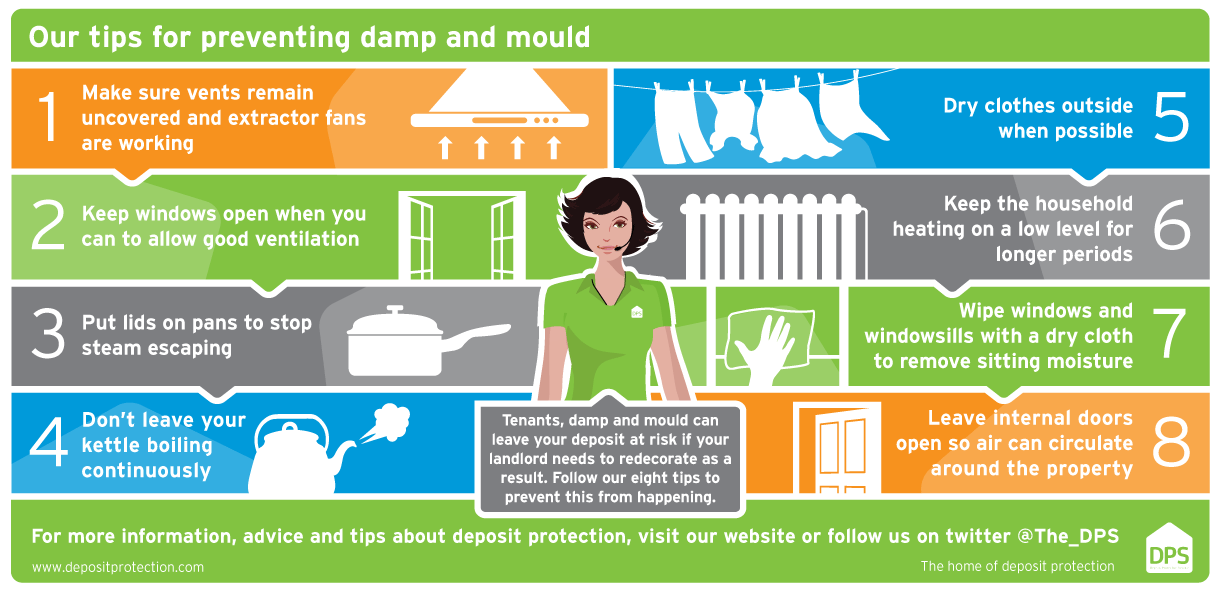Damp, Mould and Condensation
How to deal with condensation and mould in your home
Identifying condensation, damp and mould can be very complicated. What are the differences and who is responsible – the landlord or the tenants?
It is useful to understand how to identify, treat, and prevent all three. Condensation can be a recurring problem that can lead to bigger issues such as damp and mould. Importantly, although condensation, damp and mould are often similar in appearance they need to be treated differently.
What is condensation?
Condensation in a property can be a result of issues with the property itself, such as a lack of damp proofing, but can also be caused when warm moist air from cooking, showering or drying clothes can’t escape and hits a cold surface. This then condenses and water droplets can develop. When a room is not well ventilated the air is unable to dissipate and collects on surfaces such as windows and tiles. If condensation collects on other surfaces such as wallpapered or plastered walls, clothing or on carpets, it is not always visible and is often identified through a musty smell.
Causes of condensation
The three main causes of condensation are:
- The room temperature is too cold
- There is a lack of ventilation in an area of high steam production – from cooking, showering or drying clothes.
- The property has moisture rich air
Other causes of condensation include:
- Lack of insulation – older buildings may not have a sufficient level of insulation and are therefore more susceptible to condensation
- Cold spots – some materials, such as concrete beams, used to construct a property can be difficult to adequately insulate
- Colder weather – condensation is more common during cold weather and is more likely to appear on cold surfaces
What is Mould?
Mould is a fungus that grows in areas with high humidity and excess moisture and is usually caused by condensation and damp within the property. Over time this provides the perfect environment for mould to develop. The development of mould can be avoided if the property is ventilated adequately and by ensuring excess moisture doesn’t build up. Once mould has started to grow physical spores will develop, as well as a ‘damp’ smell.
Removing Mould from a Property
- Identifying the root cause of mould growth is the first step. Once the cause has been identified the clean-up can begin. If the mould is minimal then it can be removed by sufficient cleaning. Specialist mould removal wash must be used, as well as protective clothing and gloves. Carpets should be shampooed and mildewed clothes dry cleaned. It is important to take these precautions, especially when dealing with black mould, as spores can be toxic.
Top Tips for preventing condensation and mould
Leave heating on a low setting for longer periods during colder months, keeping rooms at a constant temperature.
- Ensure there are working extractor fans in areas where moisture and steam may be produced such as the kitchen or bathroom.
- Don’t leave your kettle boiling continuously.
- Put lids on pans when cooking.
- Wipe away condensation as soon as it appears
- Air the property as much as possible by opening windows to help avoid condensation build up.
- Wipe windows and windowsills with a dry cloth to remove sitting moisture.
- Ensure doors to “wet areas” are closed to avoid moisture or steam in a room during and after a bath or shower, to stop it spreading throughout other rooms in the property.
- Dry clothes outside when possible or on a clothes airer if not. Don’t dry wet clothes on radiators or other heaters in the property.
Damp Problems
Condensation is usually caused by everyday activities in the home where as damp is more often a result of building defects. Therefore this is likely to be the landlord’s responsibility, however, tenants should be aware that their lifestyle can contribute to the development of damp in a property, for example through the excessive production of moisture.
Examples of damp include:
- Rising damp – usually caused by a failure of damp proof coursing or membrane in the walls or floor of the property
- Penetrating damp – this is where rain or water seeps through cracks in the brick work or tiles
- External plumbing issues – cracked or weathered piping may introduce water into the property
- Blocked guttering – common during the autumn and winter months where debris clogs pipework leading to a build-up of water which can seep into the property
Spot the signs
- A ‘damp’ musty smell
- Dark or discoloured areas appearing on walls
- Damp patches that begin at the base of the wall and then gradually move upwards
- Brown or yellow staining or a ‘tide mark’ on the wall
- The walls or ceilings may feel cold and wet to the touch
- Peeling wallpaper and/or paintwork
- Damaged plaster or skirting boards
If you suspect you have damp at your property, please report this via our 24 hour online reporting system: https://mint-homes.fixflo.com
The Deposit Protection Service (DPS) have produced this useful top tips guide:

Need to report an issue?
If you have a maintenance issue that you need to report, please use our reporting system:
Report An Issue